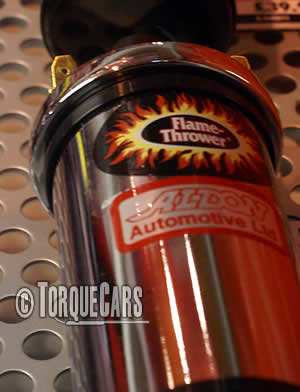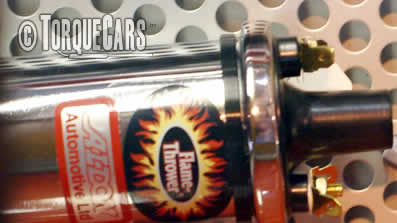Performance sports ignition coil
"High tension stuff"

Firstly lets look at the job of a coil and what it does.
Just as a power transformer converts mains 240 volts into a usable 9 volts for your charger or appliance a coil will increase the voltage.
A car battery/alternator will produce a paltry 12volts, certainly not enough to jump an air gap and create a spark.
An ignition coil raises the voltage in some installations between 20 and up to 40,000 volts and this allows the creation of a spark which can jump the air gap between the plugs.
Typically a car will have a coil between the battery and the distributor which feeds the charge in turn to each of the plugs.
(Most modern cars use an electronic ignition timing circuit to distribute the charge).
Older cars use HT leads (high tension) to carry the charge to the plugs.
In many modern engines there is a separate coil pack (a lead with a built in coil) with a separate coil for each spark plug. These are usually mounted directly on top of the plug. Some engines have one coil driving 2 spark plugs.
A faulty coil can also reduce the spark voltage to the point that no spark happens and you end up with a misfire. If you have just one coil and it fails completely your engine will not work. Typically a failing coil will start to misfire for a while before it fails.
Having multiple coils allows the car to "limp home" with one less cylinder although if you have a V6 or V8 engine the number of coils can really push up the replacement cost. It also avoids the need to carry a high voltage charge along a HT lead to an engine and the associated problems of split or damaged leads and arcing.
If you have multiple coil packs and one fails, make sure you get a spare. Very often, as our forum members can testify, the coil packs will tend to all fail within short succession.
So we now move onto performance ignition coils and coil packs.

We all know that heat build up can cause problems resistance and conductivity. In a high performance engine a lot more strain is put on the ignition coil.
A sport coil is designed to tolerate the extra demands placed upon it.
Sports coils also increase the power to the plug and theoretically allowing a larger spark. To benefit from this you need to match a sports coil with a larger plug gap.
Please note that manufactures set their plug gaps to take into account the space between the tip of the plug and the top of the cylinder.
If you set the gap too wide then you risk the cylinder smashing off the end of the plug leaving a sharp metal fragment flying around in your cylinder.
You have been warned. To discuss all aspects of ignition coils and car tuning please join us in our friendly forum.
If you liked this page please share it with your friends, drop a link to it in your favourite forum or use the bookmarking options to save it to your social media profile.
Check out TorqueCars new YouTube channel, and see their awesome new content...
Feedback
Please use our forums if you wish to ask a tuning question, and please note we do not sell parts or services, we are just an online magazine.
Help us improve, leave a suggestion or tip
